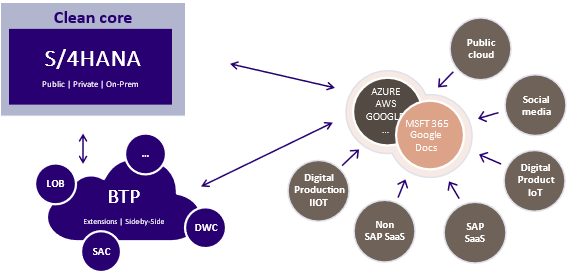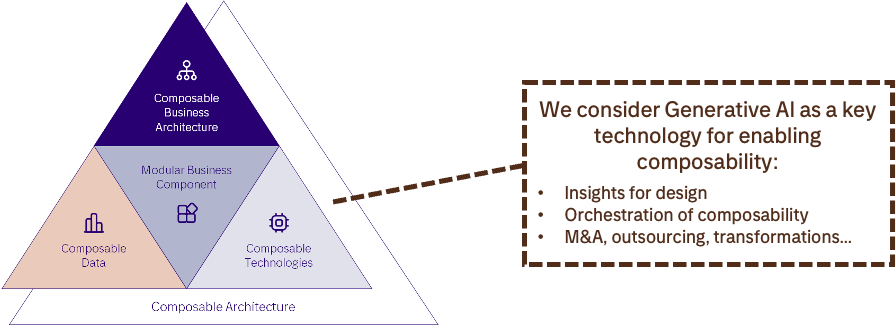In the era of AI technologies, a look at SAP's strategic direction reveals a transformative journey ahead. Adapting to AI requires us to reevaluate our ways of working, as well as how we design our businesses and architectures for the future.
In this article we offer insights into the evolving landscape of SAP architecture and its synergy with composable architecture. AI has emerged as a pivotal force, shaping the way we envision and enable the future.
To learn more about composable architecture and one part the headless ERP, read these blog posts by my colleagues:
Composable Architecture: Exploring business design and architecture of the future by Janne Vihervuori
Headless SAP - Improved usability and a smooth transition to S/4HANA by Kari Pietiläinen
SAP and the composable SAP
If we listen to the CEO of SAP, Christian Klein, the direction he is giving is clearly pointing at a future of a Clean Core composable SAP built to interact with other components. It features BTP in the center, with SAP and partner developed microservices supported by strong API management to interact with both SAP’s own and external services.
Gone are the days where we did custom-code enhancements in Z code in separate namespaces. Now we are heading into the future of open source, low code/no code and AI. This will enable greater business flexibility and the agility to act on future changes.
Embracing a dynamic landscapes and composable architecture
As SAP expands its capabilities beyond the core ERP, integrated solutions within SAP BTP and external services are reshaping our business landscapes. The future architecture – enriched with SAAS, PAAS, and diverse microservices – places a renewed emphasis on the concept of a clean core.

Figure 1: Future landscapes after migration – not only SAP
Post S/4HANA transformation, your architecture will most likely mirror the vision depicted above. This architecture will cause us to put more focus on:
- End-to-End Thinking: Prioritize holistic views over process-centric approaches.
- Enterprise Architecture: Optimize your landscape to align seamlessly with your business objectives.
- Security and Compliance: With myriad solutions available, safeguarding data becomes paramount.
- Data Evolution: Adapt to new data requirements, emphasizing reusable and autonomous data.
- Avoiding Vendor Lock-In: Design components outside the core as composable, thereby minimizing dependencies.

Figure 2: AI is an enabler to reach the composable architecture
AI's Role in Composable Architecture
Within this framework, the integration of Artificial Intelligence – specifically Generative AI –introduces a transformative layer. While existing systems may resemble a composable architecture, the true essence lies in the ability of tools to enable independent business context and data operations. Current systems often foster vendor lock-in scenarios, hindering the agility needed for a truly composable system.
Tools for composability:
Some of the new arsenal of tools becomes pivotal, including machine learning, digital simulation, data virtualization, evolving integration technologies, and Generative AI. These tools empower businesses to break free from the constraints of traditional integrations, and facilitate the creation of modular, adaptable, and independent components and microservices. Some of these tools are not new and are very extensively used already, but what we see is that growth in their usage will be exponential.
Generative AI's transformative potential:
Though part of the broader composable technology spectrum, Generative AI stands out as a catalyst for change. It acts as a bridge between rigid systems and adaptive solutions, making the equivalent leap from horse-drawn carriages to self-operating flying cars. By supporting the automation and optimization of processes, Generative AI enables dynamic responses to changing conditions – thus enhancing the overall agility of the architecture.
Unlocking adaptive processes:
Incorporating Generative AI into composable architecture unlocks a realm of possibilities. For instance, in automated processes – such as converting purchase requisitions to purchase orders – Generative AI can optimize information usage from multiple sources. This enables us to enhance the process for new business requirements, which means sustainability and agility in our procurement decisions.
Whereas today we are most often bound by the info records or agreements that exist in the system, with AI we can include more data from other services. Examples are CO2 impact, market news, transportation optimization, historical delivery accuracy – the list goes on.
Although most of these scenarios can be achieved with machine learning, Generative AI speeds up the process. With the generation of synthetic data and integration with diverse sources, Generative AI enhances the accuracy of the machine-learning processes.
Content creation reimagined:
Consider the labor-intensive process of content creation. Generative AI revolutionizes this workflow, streamlining the generation of product information, translations, and classifications. This not only saves time, but also introduces a more dynamic and collaborative approach.
Generative AI generates content, integrates with machine learning for translation, and involves user reviews – creating a seamless and efficient content-creation pipeline. In addition, we have the ability for personalization with the “personal touch” that we are all becoming accustomed to.
How can we help you on this journey!
To realize the potential of AI, many are now accelerating their ERP enhancement and cloudification projects. GenAI is clearly something that will have an impact across processes. It will have a significant transformative power to utilize data much more efficiently to improve business resilience and efficiency.
It's a multi-tool that allows us to do things we couldn't do before. The focus should still be on resolving business problems, not on finding things that we can do with AI. Here we can help you with our knowledge of the new AI toolsets.
Our guide would be to:
- Set up a governance around AI, including security and data.
- Analyze business needs.
- Establish a use case qualification framework.
- Set up a roadmap for that is feasible in the short and long term.
- Deliver the solution.
- Create and measure business value.
Tietoevry Tech Services works with customers on E2E services from advice to implementation of data, cloud and core ERP solutions. These capabilities form the basis to harness the power of GenAI and support our customers, from qualifying business needs and implementing new ways of working, to hands-on training of Large Language Models (LLM) with your data for your specific needs.
Conclusion
When we integrate Generative AI with a composable architecture, we unlock the potential to create processes and solutions that dynamically adapt to changing conditions. This paves the way for a more agile and responsive business environment.
Contact us
Ready to take the next step?
If you are ready to take the next steps, we can help you on the way.
Contact usRobert helps guide customers through their SAP journeys with a passion for process improvement and digitalization. With over 20 years of industry experience in large enterprises and roles spanning from key user to global program manager, Robert knows the challenges companies can have from all levels. Robert is utilizing his solution experience to help customers to optimize, automate and digitalize their business processes.